| UNESCO World Heritage Site | |
|---|---|
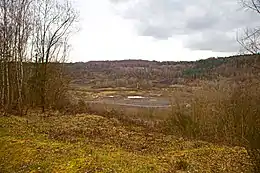 | |
| Location | Darmstadt-Dieburg, Hesse, Germany |
| Criteria | Natural: (viii) |
| Reference | 720bis |
| Inscription | 1995 (19th Session) |
| Extensions | 2010 |
| Area | 42 ha (100 acres) |
| Buffer zone | 22.5 ha (56 acres) |
| Coordinates | 49°55′03″N 8°45′24″E / 49.9175°N 8.7567°E |
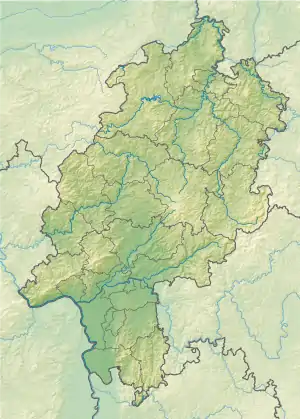 Location of Messel pit in Hesse  Messel pit (Germany) | |
The Messel pit (German: Grube Messel) is a disused quarry near the village of Messel (Landkreis Darmstadt-Dieburg, Hesse) about 35 km (22 mi) southeast of Frankfurt am Main, Germany. Bituminous shale was mined there. Because of its abundance of well-preserved fossils dating from the middle of the Eocene, it has significant geological and scientific importance.[1] Over 1000 species of plants and animals have been found at the site.[1] After almost becoming a landfill, strong local resistance eventually stopped these plans and the Messel pit was declared a UNESCO World Heritage Site on 9 December 1995. Significant scientific discoveries about the early evolution of mammals and birds are still being made at the Messel pit, and the site has increasingly become a tourist site as well.[1]
History
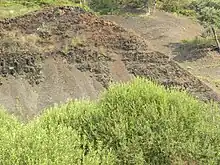
Brown coal and later oil shale was actively mined from 1859. The pit first became known for its wealth of fossils around 1900, but serious scientific excavation only started around the 1970s, when falling oil prices made mining the quarry uneconomical. Commercial oil shale mining ceased in 1971 and a cement factory built in the quarry failed the following year. The land was slotted for use as a landfill, but the plans came to nought and the Hessian state bought the site in 1991 to secure scientific access. In the few years between the end of mining and 1974, when the state began preparing the site for garbage disposal, amateur collectors were allowed to collect fossils. The amateurs developed the "transfer technique" that enabled them to preserve the fine details of small fossils, the method still employed in preserving the fossils today.[2]
Many of the known specimens from the site have come from amateur collectors and in 1996, an amnesty on previously collected fossils was put in effect, in the hope of getting privately owned collections back into public ownership and available to science.
Depositional characteristics

The current surface of the Messel pit is roughly 60 m (200 ft) below the local land and is about 0.7 km2 (0.27 sq mi) in area. The oil-shale bed originally extended to a depth of 190 m (620 ft).[3] 47 million years ago in the Eocene when the Messel deposits formed, the area was 10° further south than it is now. The period was very close to the Early Eocene Climatic Optimum and the climate and ecology of the site were very different, characterised by a mean annual temperature of 22°C and a large series of maar lakes surrounded by lush sub-tropical forests that supported an incredible diversity of life.[4] The Messel lake bed was probably a center point for drainage from nearby rivers and creeks.

The pit deposits were formed during the Eocene Epoch of the Paleogene Period about 47 million years ago, based on dating of basalt fragments underlying fossilbearing strata.[5] Oil shale, formed by the slow anoxic deposition of mud and dead vegetation on the lake bed, is the primary rock at the site. Its sediments extend 13 m (43 ft) downward and lie atop an older sandstone foundation. The fossils within the shale show a remarkable clarity and preservation due to the unique depositional characteristics of the lake and so the Messel pit represents a Konservat-Lagerstätte. The upper stratifications of the lake most certainly supported a variety of organisms, but the bottom was subject to little disturbance by current, spawning a very anoxic environment. This prevented many epifaunal and infaunal species from inhabiting this niche and thus bioturbation was kept at a minimum. Overturn of the lake layers (caused by seasonal variations) lowered oxygen content near the surface and led to a periodic "die-off" of aquatic species. Combined with a relatively low rate of deposition, 0.1 mm (0.0039 in) per year, this provided a prime environment for the preservation of fauna and flora.
Volcanic gas releases
The area around the Messel Pit is believed to have been geologically and tectonically active during the Eocene. Leading scientists hypothesize that events much like the 1986 volcanic gas releases at Lake Nyos, Cameroon, could account for the large deposition of non-aquatic species (Franzen & Koster, 1994). Periodic subsurface shifts possibly released large concentrations of reactive gases (such as carbon dioxide and hydrogen sulfide) into the lake and adjoining ecosystems, killing susceptible organisms. During these releases, birds and bats might have fallen in if near the lake surface and terrestrials could be overwhelmed when near the lake shore. Since the lake was very deep, animals that fell in it drifted downwards into oxygen- and bacteria-poor water, where they were preserved remarkably well, being overlaid by successive layers of mud that petrified later, thus producing an aggregation of fossils of exceptional quality, quantity, integrity, and variety. However, other hypotheses have been postulated as well, and have suggested a Cyanobacteria bloom origin resulting in the poisoning of the animals. This last one was considered to be necessary in order to explain the occurrence of excellent fossils throughout the entire sedimentary sequence (Koenigswald & others, 2004).
Fossils
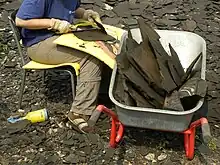
The Messel Pit provides the best preserved evidence of Geiseltalian flora and fauna so far discovered, with over 1000 species identified.[1] Most other sites are lucky to contain partial skeletons, but Messel boasts extensive preservation of structural integrity, even going so far as to preserve the fur, feathers and "skin shadows" of some species. Unusual preservation has sparked some closely reasoned interpretations. The symptomatic "dumb-bell"-shaped bite marks on either side of the leaf vein on a fossilised leaf have been identified as the death-grip of a carpenter ant terminally parasitized by the fungus Ophiocordyceps unilateralis, that, apparently then as today, commandeered its behavior, in order to release its spores from a favourable location; it is the earliest concrete sample of fungal behavioural manipulation.[6]
The diversity of species is remarkable partly as a result of the hypothesized periodic gas releases. A brief summary of some of the fossils found at the site follows:
- Nine mating pairs of fossil turtles have been found. The turtles, Allaeochelys crassesculpta, were in coitus (in the act of having sex).[7] They are male-female pairs, with the male's tail tucked under the female, which is how they copulate. Their death must have been rapid. It is supposed that the turtles had started mating in the aerated surface waters of the ancient lake. As they sank into deeper water, they were overcome by the release of toxic volcanic gas. They were then buried in the lakebed sediment.[8] Turtles belonging to this clade are still living. They have lost their reptilian scales, and their skin absorbs oxygen from the water. Normally, this is an advantage: it helps them stay submerged for long periods. However, under anoxic conditions it is a disadvantage, because carbon dioxide and dissolved poisons are absorbed as well.[8]
- Over 10,000 fossilized fish of numerous species
- Thousands of aquatic and terrestrial insects, some with distinct coloration still preserved
- Innumerable small mammals including pygmy horses, large mice, primates, ground dwellers (hedgehogs, marsupials, pangolins), aardvark relatives and bats. The fossilized bat specimens have provided insights into the evolution of echolocation.[9]
- Large numbers of birds, particularly predatory species.
- Crocodiles, frogs, turtles, salamanders and other reptiles or amphibians
- Remains of over 30 distinct plant species, including palm leaves, fruits, pollen, wood, walnuts and grapevines
The following is only a partial list:

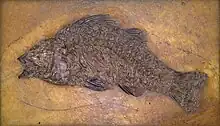
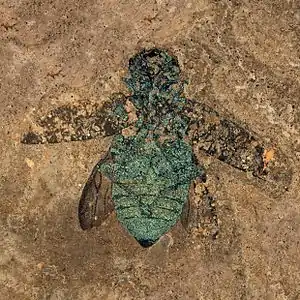
Mammals
- Darwinius masillae, identified in 2009 as an adapiform primate[10]
- Kopidodon, an extinct arboreal cimolestan
- Leptictidium, an extinct omnivorous hopping mammal (of the leptictid family)
- Propalaeotherium, an early relative of horses
- Ailuravus, a rodent
- Peradectes, a metatherian
- Palaeochiropteryx, a bat
- Lesmesodon, a small hyaenodontid
- Eomanis, an early pangolin
- Eurotamandua, a scaleless, anteater-like pangolin
- Europolemur, a primate
- Hyrachyus, ancestor of rhinoceroses
- Paroodectes, an early carnivorous mammal
- Messelogale, an early carnivorous mammal
- Pholidocercus, an early hedgehog
- Macrocranion, an early long-tailed hedgehog
- Masillamys, an early rodent
- Messelobunodon, an early artiodactyl
- Godinotia, an early primate
- Buxolestes, a semiaquatic, otter-like cimolestan
Birds
- Palaeotis, an early struthionid
- Strigogyps sapea (formerly Aenigmavis) a cariamiform
- Eocoracias, an early coraciiform with known coloration
- Messelornis, the Messel-bird; a species of gruiform
- Masillastega, a freshwater sulid
- Lapillavis, a possible trogonid relative
- Cypseloramphus, a basal apodiform
- The Messelasturidae (Messelastur and Tynskya), carnivorous relatives of modern parrots
- Palaeoglaux, an early owl with enigmatic breast feathers
- Paraprefica, an early potoo
- Paraortygoides, a galliform[11]
- Masillaraptor, an early falconiform
- Parargornis, an early apodiform
- Messelirrisor, a tiny bucerotiform closely related to hoopoes and wood-hoopoes
- Selmes (an anagram of "Messel"), a mousebird with stubby toes
- Gastornis (formerly Diatryma), a large, flightless anseriform
- Hassiavis,[12] a member of Cypselomorphae
- Quasisyndactylus,[12] a member of Alcediniformes
- Vanolimicola, a possible charadriiform[13]
- A currently unnamed lithornithid, a sandpiper-like paleognath, the first record of its kind in Middle Eocene Europe.[14]
Reptiles
- Asiatosuchus, a large crocodile
- Diplocynodon, an alligator
- Hassiacosuchus, a durophagous alligator
- Bergisuchus, a sebecosuchian crocodiliform
- Eoconstrictor, 2-m snakes related to Neotropical boas, Boinae[15]
- Messelophis, a tiny, live-bearing or viviparous boa [16]
- Messelopython, the oldest known relative of pythons[17]
- Cryptolacerta, a lizard with affinities to amphisbaenians
- Geiseltaliellus, a lizard with affinities to Corytophaninae
- Allaeochelys crassesculpta, aquatic turtles related to Carettochelys
Fish
- A bowfin, variously described as Amia (the modern genus) or Cyclurus
- Amphiperca, an early perch
- Palaeoperca, another early perch
- Atractosteus, a gar
- eel
Insects
- Hemiptera
- Wedelphus dichopteroides[18]
- Hymenoptera
- Casaleia eocenica
- Cephalopone – Cephalopone grandis and Cephalopone potens
- Cyrtopone – Cyrtopone curiosa, Cyrtopone elongata, Cyrtopone microcephala, and Cyrtopone striata
- Gesomyrmex pulcher
- Messelepone leptogenoides
- Pachycondyla eocenica
- Pachycondyla lutzi
- Pachycondyla? messeliana
- Pachycondyla parvula
- Pachycondyla petiolosa
- Pachycondyla petrosa
- Protopone – Protopone? dubia, Protopone germanica, Protopone magna, Protopone oculata, Protopone sepulta, and Protopone vetula
- Pseudectatomma – Pseudectatomma eocenica and Pseudectatomma striatula
- Titanomyrma gigantea
- Titanomyrma simillima
IUGS geological heritage site
Describing the Messel Pit Fossil Site as 'richest geosite in the world for understanding the living environment of the Eocene, as it includes exceptionally well-preserved fossils', the International Union of Geological Sciences (IUGS) included the site's Eocene record in its list of 100 'geological heritage sites', published in October 2022. The organisation defines an IUGS Geological Heritage Site as 'a key place with geological elements and/or processes of international scientific relevance, used as a reference, and/or with a substantial contribution to the development of geological sciences through history.'[19]
Access
Exhibits from the pit may be seen in the Messel town,[20] the fossil Museum in Messel,[21] the Hessisches Landesmuseum in Darmstadt (5 km (3.1 mi) from Messel)[22] and also the Senckenberg Museum in Frankfurt am Main (some 30 km (19 mi) from Messel).[23] Casual visitors can park close to the pit and walk around 300 m (0.19 mi) to a viewing platform overlooking the pit. Entrance to the pit is only possible as part of a specially organized tour.
See also
- Lagerstätte
- List of fossil sites (with link directory)
- Paleofauna of the Messel Pit
References
- 1 2 3 4 "Messel Pit Fossil Site". UNESCO World Heritage Centre. United Nations Educational, Scientific, and Cultural Organization. Retrieved 2 July 2022.
- ↑ "The Messel Pit Fossil Site". Archived from the original on 7 February 2013. Retrieved 2 April 2015.
- ↑ United Nations Environment Programme-World Conservation Monitoring Centre (Content Partner); Mark McGinley (Topic Editor). 2008. "Messel Pit fossil site, Germany." In: Encyclopedia of Earth. Eds. Cutler J. Cleveland (Washington, D.C.: Environmental Information Coalition, National Council for Science and the Environment). [First published in the Encyclopedia of Earth 29 November 2007; Last revised 8 July 2008; Retrieved 22 May 2009. Pit fossil site, Germany article
- ↑ Grein, Michaela; Utescher, Torsten; Wilde, Volker; Roth-Nebelsick, Anita (1 June 2011). "Reconstruction of the middle Eocene climate of Messel using palaeobotanical data". Neues Jahrbuch für Geologie und Paläontologie, Abhandlungen. 260 (3): 305–318. doi:10.1127/0077-7749/2011/0139. Retrieved 12 July 2019.
- ↑ Mertz, D. F., Renne, P. R. (2005): A numerical age for the Messel fossil deposit (UNESCO World Heritage Site) derived from 40
Ar/39
Ar dating on a basaltic rock fragment. Courier Forschungsinstitut Senckenberg no 255: pp 7–75. - ↑ Guardian.com, "'Zombie ants' controlled by parasitic fungus for 48 m years", 18 August 2010]: accessed 21 August 2010
- ↑ Amos, Jonathan 2012. Turtles fossilised in sex embrace. BBC News: Science & Environment.
- 1 2 Joyce, W. G; Micklich, N; Schaal, S. F. K; Scheyer, T. M (2012). "Caught in the act: The first record of copulating fossil vertebrates". Biology Letters. 8 (5): 846–8. doi:10.1098/rsbl.2012.0361. PMC 3440985. PMID 22718955.
- ↑ Habersetzer, J.; Storch, G. (October 1992). "Cochlea size in extant chiroptera and middle eocene microchiropterans from messel". Naturwissenschaften. 79 (10): 462–466. Bibcode:1992NW.....79..462H. doi:10.1007/BF01139198. S2CID 12463331.
- ↑ Franzen, J. L., Gingerich, P. D., Habersetzer, J., Hurum, J. H., Von Koenigswald, W., & Smith, B. H. (2009). Complete primate skeleton from the middle Eocene of Messel in Germany: morphology and paleobiology. PLoS one, 4(5), e5723. https://doi.org/10.1371/journal.pone.0005723
- ↑ Dyke, Gareth J; Gulas, Bonnie E (2002). "The Fossil Galliform Bird Paraortygoides from the Lower Eocene of the United Kingdom" (PDF). American Museum Novitates (360): 1–14. doi:10.1206/0003-0082(2002)360<0001:TFGBPF>2.0.CO;2. hdl:2246/2913. S2CID 59131455.
- 1 2 Mayr, G.. (2004). New specimens of Hassiavis laticauda (Aves: Cypselomorphae) and Quasisyndactylus longibrachis (Aves: Alcediniformes) from the Middle Eocene of Messel, Germany. CFS Courier Forschungsinstitut Senckenberg. 252. 23-28.
- ↑ Mayr, Gerald (2017). "A small, 'wader-like' bird from the Early Eocene of Messel (Germany)". Annales de Paléontologie. 103 (2): 141–7. Bibcode:2017AnPal.103..141M. doi:10.1016/j.annpal.2017.01.001.
- ↑ Mayr, Gerald (2008). "First substantial Middle Eocene record of the Lithornithidae (Aves): A postcranial skeleton from Messel (Germany)". Annales de Paléontologie. 94 (1): 29–37. Bibcode:2008AnPal..94...29M. doi:10.1016/j.annpal.2007.12.004.
- ↑ Scanferla, A. & K.T. Smith (2020) Exquisitely preserved snake fossils of Messel: insight into the evolution, biogeography, habitat preferences and sensory ecology of early boas. Diversity 12(3): 100. https://doi.org/10.3390/d12030100
- ↑ Chuliver, M., A. Scanferla & K.T. Smith (2022) Live birth in a 47-million-year-old snake. The Science of Nature – Naturwissenschaften 109: 56. https://doi.org/10.1007/s00114-022-01828-3
- ↑ Zaher, H. & K.T. Smith (2020) Pythons in the Eocene of Europe reveal a much older divergence of the group in sympatry with boas. Biology Letters 16: 20200735. https://doi.org/10.1098/rsbl.2020.0735
- ↑ Szwedo, J. (2008). "A new tribe of Dictyopharidae planthoppers from Eocene Baltic amber (Hemiptera: Fulgoromorpha: Fulgoroidea), with a brief review of the fossil record of the family". Palaeodiversity. 1: 75–85.
- ↑ "The First 100 IUGS Geological Heritage Sites" (PDF). IUGS International Commission on Geoheritage. IUGS. Retrieved 13 November 2022.
- ↑ "Home". www.grube-messel.de (in German). Retrieved 13 May 2018.
- ↑ "Home". Fossilien- und Heimatmuseum Messel (in German). 24 July 2022. Retrieved 30 December 2022.
- ↑ "Messel Pit – Hessisches Landesmuseum". www.hlmd.de. Retrieved 13 May 2018.
- ↑ "SENCKENBERG world of biodiversity | Museums | Museum Frankfurt | The Museum | Exhibitions | World natural heritage "." www.senckenberg.de. Archived from the original on 24 September 2017. Retrieved 13 May 2018.
Further reading
- Smith, Krister T.; Schaal, Stephan; Habersetzer, Jörg; Herlyn, Hendrik G.; Senckenberg Gesellschaft für Naturforschung (2018). Messel : an ancient greenhouse ecosystem. Stuttgart. ISBN 978-3-510-61411-0. OCLC 1054359916.
{{cite book}}: CS1 maint: location missing publisher (link) - Harms, Franz-Jürgen; Schaal, Stephan (2005). Current geological and paleontological research in the Messel Formation. Stuttgart: E. Schweizerbart'sche Verlagsbuchhandlung (Nägele u. Obermiller). ISBN 3-510-61381-3. OCLC 64571829.
- Mangel, Gerd (2011). Faszination Welterbe Grube Messel zu Besuch in einer Welt vor 47 Millionen Jahren (in German). Stuttgart. ISBN 978-3-510-61398-4. OCLC 698592675.
{{cite book}}: CS1 maint: location missing publisher (link) - Kächler, Ernst Rudolf; Grube-Messel-Verwaltungsgesellschaft (2000). Window to primeval times Messel Pit, world heritage site in the State of Hessen (in German). Wiesbaden: Grube-Messel-Verwaltungsgesellschaft c/o Hessisches Ministerium für Wissenschaft und Kunst. OCLC 174602085.
- Schaal, Stephan; Ziegler, Willi (1992). Messel : an insight into the history of life and of the earth. Oxford: Clarendon Press. ISBN 0-19-854654-8. OCLC 25747250.
- Gruber, Gabriele; Micklich, Norbert; Hessisches Landesmuseum Darmstadt (2007). Messel : Schätze der Urzeit (in German). Stuttgart: Theiss. ISBN 978-3-8062-2092-6. OCLC 600404474.
- Gruber, Gabriele; Sandrock, Oliver; Wappler, Torsten (2018). "DARMSTADT: The Paleontological Collections of Hessisches Landesmuseum Darmstadt". Paleontological Collections of Germany, Austria and Switzerland. Natural History Collections. Cham: Springer International Publishing. pp. 157–164. doi:10.1007/978-3-319-77401-5_14. ISBN 978-3-319-77400-8. ISSN 2510-1862.
- Aubert, Hans-Joachim; Deutsche Unesco-Kommission (2010). UNESCO-Welterbe in Deutschland [eine Publikation der Deutschen Unesco-Kommission und des Auswärtigen Amts der Bundesrepublik Deutschland] = UNESCO world heritage in Germany (in German). Bonn. ISBN 978-3-940785-14-5. OCLC 612325291.
{{cite book}}: CS1 maint: location missing publisher (link)



